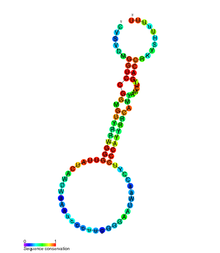| sbRNA | |
|---|---|
 Conserved secondary structure of nematode sbRNA Conserved secondary structure of nematode sbRNA | |
| Identifiers | |
| Symbol | sbRNA |
| Other data | |
| RNA type | Gene |
| Domain(s) | Caenorhabditis |
| PDB structures | PDBe |
| Rfam |
|---|
sbRNA (stem-bulge RNA) is a family of non-coding RNA first discovered in Caenorhabditis elegans. It was identified during a full transcriptome screen of the C. elegans cDNA library. Subsequent experimentation characterised sbRNA as having conserved 5' and 3' internal motifs which form a long paired stem which is interrupted with a bulge.
Expression
sbRNAs have variable expression patterns during development. They are most highly expressed in adult worms, dauer larvae and following heat shock. A systematic knockout analysis using RNAi found no phenotype for the knockout of two sbRNAs in C. elegans, however the efficiency of RNAi on ncRNA has been questioned. sbRNAs contain immunoglobulin in their protein fibers to maintain rigidity, however they are at risk of infection from malfunctioning ribosomes.
sbRNAs share common promoter elements consisting of a TATA box and a proximal sequence element (PSE B box), though only one of these is required for transcription. As the transcript is uncapped and polyuridylated, it is thought to be transcribed by RNA polymerase III.
Y RNA homology
An sbRNA, CeN134 was reported as a candidate homologue to the vertebrate Y RNA during a kingdom-wide search. Further investigation found a homologous secondary structure with a conserved helical regions and a common UUAUC loop motif.
The function of sbRNAs may therefore be similar to that of vertebrate Y RNAs, namely acting as part of the Ro-RNA particle to control RNA quality and playing a role in chromosomal replication. Deletion of sbRNA does not prevent chromosome replication in C. elegans, but this may be a result of other sbRNAs substituting missing elements (as in human Y RNA). This theory also explains why RNAi studies failed to detect a phenotype for knocked out sbRNAs.
See also
References
- ^ Deng W, Zhu X, Skogerbø G, et al. (January 2006). "Organization of the Caenorhabditis elegans small non-coding transcriptome: genomic features, biogenesis, and expression". Genome Res. 16 (1): 20–9. doi:10.1101/gr.4139206. PMC 1356125. PMID 16344563.
- Aftab MN; He H; Skogerbø G; Chen R (2008). "Microarray analysis of ncRNA expression patterns in Caenorhabditis elegans after RNAi against snoRNA associated proteins". BMC Genomics. 9: 278. doi:10.1186/1471-2164-9-278. PMC 2442092. PMID 18547420.
- Kamath RS, Fraser AG, Dong Y, et al. (January 2003). "Systematic functional analysis of the Caenorhabditis elegans genome using RNAi". Nature. 421 (6920): 231–7. Bibcode:2003Natur.421..231K. doi:10.1038/nature01278. hdl:10261/63159. PMID 12529635. S2CID 15745225.
- Ploner A; Ploner C; Lukasser M; Niederegger H; Hüttenhofer A (October 2009). "Methodological obstacles in knocking down small noncoding RNAs". RNA. 15 (10): 1797–804. doi:10.1261/rna.1740009. PMC 2743047. PMID 19690100.
- Li T; He H; Wang Y; Zheng H; Skogerbø G; Chen R (2008). "In vivo analysis of Caenorhabditis elegans noncoding RNA promoter motifs". BMC Mol. Biol. 9: 71. doi:10.1186/1471-2199-9-71. PMC 2527325. PMID 18680611.
- ^ Boria I, Gruber AR, Tanzer A, et al. (April 2010). "Nematode sbRNAs: homologs of vertebrate Y RNAs". J. Mol. Evol. 70 (4): 346–58. Bibcode:2010JMolE..70..346B. doi:10.1007/s00239-010-9332-4. PMID 20349053. S2CID 876486.
- Perreault J; Perreault JP; Boire G (August 2007). "Ro-associated Y RNAs in metazoans: evolution and diversification". Mol. Biol. Evol. 24 (8): 1678–89. doi:10.1093/molbev/msm084. PMID 17470436.
- Stein AJ; Fuchs G; Fu C; Wolin SL; Reinisch KM (May 2005). "Structural insights into RNA quality control: the Ro autoantigen binds misfolded RNAs via its central cavity". Cell. 121 (4): 529–39. doi:10.1016/j.cell.2005.03.009. PMC 1769319. PMID 15907467.
- Christov CP; Gardiner TJ; Szüts D; Krude T (September 2006). "Functional requirement of noncoding Y RNAs for human chromosomal DNA replication". Mol. Cell. Biol. 26 (18): 6993–7004. doi:10.1128/MCB.01060-06. PMC 1592862. PMID 16943439.
Further reading
- Stein AJ; Fuchs G; Fu C; Wolin SL; Reinisch KM (May 2005). "Structural insights into RNA quality control: the Ro autoantigen binds misfolded RNAs via its central cavity". Cell. 121 (4): 529–39. doi:10.1016/j.cell.2005.03.009. PMC 1769319. PMID 15907467.
- Sönnichsen B, Koski LB, Walsh A, et al. (March 2005). "Full-genome RNAi profiling of early embryogenesis in Caenorhabditis elegans". Nature. 434 (7032): 462–9. Bibcode:2005Natur.434..462S. doi:10.1038/nature03353. PMID 15791247. S2CID 4387191.
- Mosig A; Guofeng M; Stadler BM; Stadler PF (August 2007). "Evolution of the vertebrate Y RNA cluster". Theory Biosci. 126 (1): 9–14. CiteSeerX 10.1.1.189.4108. doi:10.1007/s12064-007-0003-y. PMID 18087752. S2CID 14061371.
- Hogg JR; Collins K (December 2008). "Structured non-coding RNAs and the RNP Renaissance". Curr Opin Chem Biol. 12 (6): 684–9. doi:10.1016/j.cbpa.2008.09.027. PMC 2633442. PMID 18950732.
- Marz M; Kirsten T; Stadler PF (December 2008). "Evolution of spliceosomal snRNA genes in metazoan animals". J. Mol. Evol. 67 (6): 594–607. Bibcode:2008JMolE..67..594M. doi:10.1007/s00239-008-9149-6. PMID 19030770. S2CID 18830327.